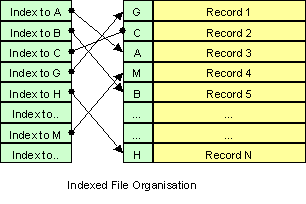SKILLSHARE EDUCATION - METHODS OF PROCESSING COMPUTER FILES
Good day everyone!
First, I will start with the types of computer files we have. Many files contain thousands or hundreds of records. The organization of these records in the disk storage device determines how fast the data can be retrieved. we all know that a file is an organized collection of related records. We can organize records in a file in this three common ways: Sequentially, by index, or by direct access. The method one uses depends on the application.
Types of Computer Files
Sequential Files
Direct Access Files
Indexed Files
1. Sequential Files: Records are physically stored in a sequential order. for example, the student records, if stored Sequentially, could be in numeric order by the student number. Sequential order is a good way to organize the data if a file is used over and over again in the same order, and if it is not subject to a large number of additions and deletions that disturb the order of records. Sequential Files method is normally common with tapes because sequential Files can only be accessed Sequentially which means that if you need to search to get the address of a student with number 50, you must first pass the first 49 records on disk to access the desired record.
2. Direct Access Files: In direct access file, a primary key field is used to an extent as the address itself, which eliminates the need to first look at the index. We use direct access suitably in an online operations that requires that the maximum possible speed of data retrieval and updating of data. Examples include, Bank Automated Teller Machine(ATM) and an airline ticket reservation systems. Direct access is not suitable for data stored on tape or for applications that require retrieving records in sequential order.
3. Indexed Files: This is the most commonly used method of organization for storing records on disks. It uses index based on the key field of records. In our example, the key field (primary key) is the student number. The computer also creates an index that keeps track of the records primary key and the disk location of the record. To clearly understand this technique better, think about how difficult it would be to find a section of a book on indexed Files by Sequentially paging through the book, but how easy it is if you just simply look in the index to see what page describes indexed Files. Note that this method cannot be used with tapes.
Processing of Sequential Files
With sequential processing, data or transactions are collected into groups, or batches, and then submitted to the computer for processing at certain designated times, usually at prescheduled intervals. Normally this involves reading and processing the first record, then the second record, and so on.. until the last record in the file has been processed. Sequential processing is ideal in an application such as Payroll System.
Sequential processing is the most efficient when the activity is high This is because each of the programs within a payroll system generally accesses a large percentage of the available records, sequential processing represents a cost-effective approach to the problem.
Processing of Direct Files
This type of file processing is suited ideally for real-time applications involving interactive processing. Interactive processing means data are entered into the computer and processed immediately to create output. There is no appreciable delay between the time the data are entered and when the output is generated. Thus, files used in these applications must be able to access any record in the filed directly; preceding records need not be accessed.
Processing of Indexed Files
An indexed file offers the simplicity of sequential file processing as well capability for direct access. Just like in direct files, they are suited ideally for real-time applications involving interactive processing. Interactive processing means data are entered into the computer and processed immediately to create output. There is no appreciable delay between the time the data are entered and when the output is generated. Thus, files used in these applications must be able to access any record in the filed directly with the use of indexes. As records are recorded on the file, the system establishes one or more indexes to associate the key field value(s) with the storage location of the record on the file.
%20(6).png)
%20(7).png)

Very educative, thanks for sharing with us
Thanks
@steem.skillshare
@digital.mine
Congratulations, your nice post has been upvoted by the steem.skillshare curation trail!
If you wish to join as well our trail and support our community, other users, and earn the curation reward, please check out this post:
steem.skillshare curation trail post
Thanks so much I appreciate
@steemcurator02